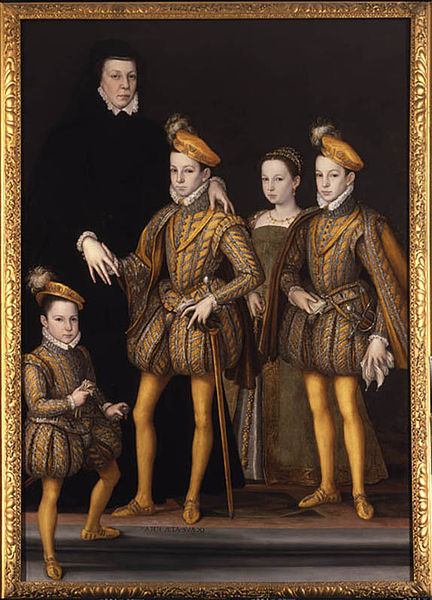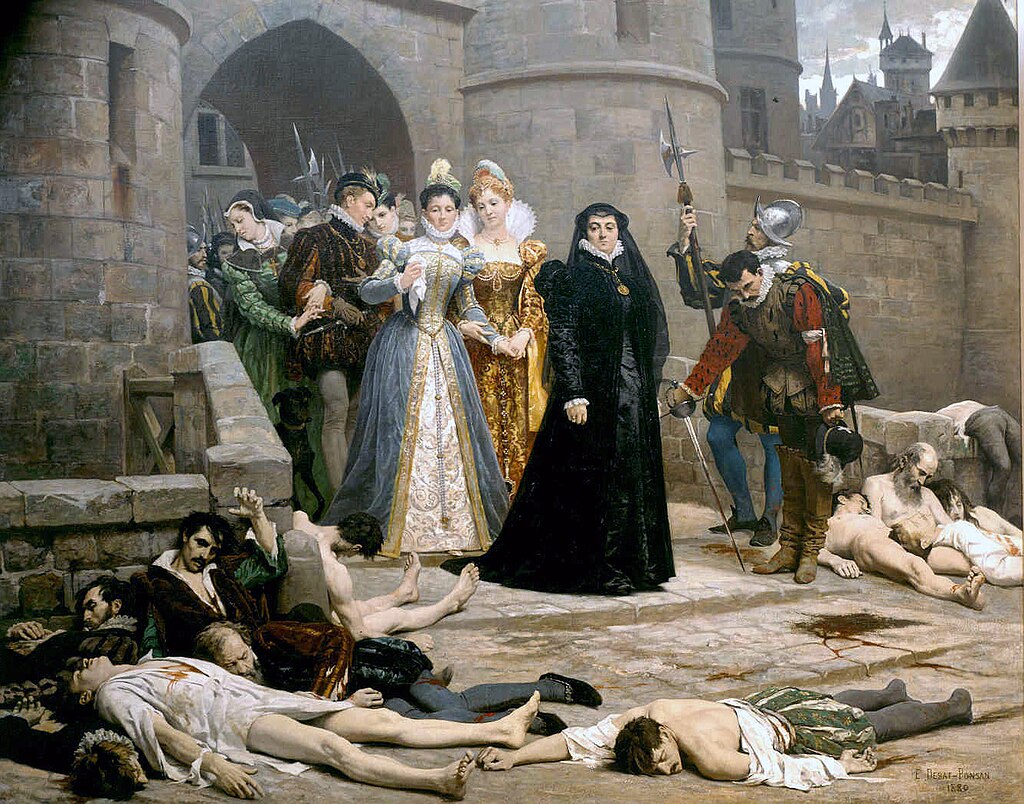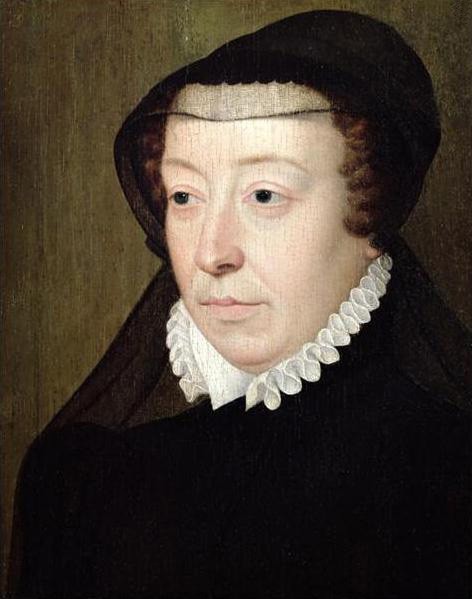by Susan Flantzer © Unofficial Royalty 2020

Catherine de’ Medici, Queen of France; Credit – Wikipedia
The wife of Henri II, King of France, Catherine de’ Medici was a member of the Italian House of Medici, a banking family and political dynasty that first came to prominence during the first half of the 15th century in the Republic of Florence. Catherine was born on April 13, 1519, in Florence, Republic of Florence, now in Tuscany, Italy. She was the only child of Lorenzo II de’ Medici, Duke of Urbino and Madeleine de La Tour d’Auvergne. Sadly, Catherine’s parents both died before she was one-month-old. Her mother died at age 20 on April 28, 1519, from puerperal fever (childbed fever), plague, or syphilis contracted from her husband. Her 26-year-old father died on May 4, 1519, from syphilis.
Catherine’s father, Lorenzo II de’ Medici, Duke of Urbino, was the only son of Piero de’ Medici and Alfonsina Orsini, and was the grandson of Lorenzo de’ Medici (Lorenzo the Magnificent), the great Renaissance ruler of Florence. Niccolò Machiavelli had dedicated his now-famous political treatise The Prince to Catherine’s father, Lorenzo II, to inform the young ruler of Florence about tactics to maintain his authority.
Catherine’s mother, Madeleine de La Tour d’Auvergne, was the daughter of Jean III de La Tour, Count of Auvergne and Lauraguais and Jeanne de Bourbon, Duchess of Bourbon. Madeleine had one sister, Anne, and they were the heirs of their father. Upon his death, they shared extensive properties in Auvergne, Clermont, Berry, Castres, and Louraguais in France. Their wealth did not go unnoticed by François I, King of France, Catherine’s future father-in-law.

François I, King of France, Catherine’s father-in-law; Credit – Wikipedia
In 1515, four years before Catherine’s birth, François I, King of France made a political agreement with Pope Leo X, born Giovanni de’ Medici, the second son of Lorenzo the Magnificent. Pope Leo’s nephew Lorenzo II de’ Medici, Duke of Urbino (Catherine’s father) had just come to power in Florence, and François I suggested a marriage alliance to cement the political agreement. He proposed that Lorenzo II should marry Madeleine de La Tour d’Auvergne, from a French noble family. Lorenzo II agreed, and François I hosted an extravagant wedding for them at the Château d’Amboise in France.
Madeleine’s sister Anne survived her by five years but died childless, so five-year-old Catherine de’Medici inherited wealth from her father and also the wealth of the Counties of Auvergne and Boulogne and the Barony of La Tour from her mother’s family. In 1519, knowing all this might happen, it is no wonder that François I wanted to raise Catherine at the French court as a potential bride for one of his sons, but Pope Leo X had other plans. He wanted Catherine to be raised within the de Medici family.
Initially, Catherine was placed under the care of her paternal grandmother, Alfonsina Orsini. After Alfonsina died in 1520, Catherine was placed in the household of her paternal aunt, Clarice de’ Medici. In 1523, Cardinal Giulio de’ Medici, the illegitimate son of Giuliano de’Medici who was the brother of Lorenzo the Magnificent, was elected Pope Clement VII and took over the responsibility of Catherine’s care. Pope Clement placed Catherine in the Palazzo Medici Riccardi in Florence, where she lived until the troops of Charles V, Holy Roman Emperor attacked and defeated Florence in 1530. Catherine was moved to the safety of Pope Clement VII’s residence in Rome.

Henri II, King of France, Catherine’s husband; Credit – Wikipedia
Due to her wealth, Catherine had several potential bridegrooms, but Pope Clement jumped at the offer to marry her to Henri, Duke of Orléans (the future King Henri II), the second son of King François I of France. At this time, Henri’s elder brother, François III, Duke of Brittany, Dauphin of France, was the heir to the throne, and there was little prospect of Henri becoming King of France.
The two fourteen-year-olds were married at the Église Saint-Ferréol les Augustins in Marseille, France, on October 28, 1533. Henri paid little attention to Catherine during the first ten years of their marriage, preferring mistresses, particularly Diane de Poitiers, who became Henri’s mistress when he was fifteen and she was 35-years-old. She remained Henri’s mistress for the rest of his life. In 1536, Henri’s elder brother François died at the age of 18, and Henri became the heir to the French throne. There were suspicions that François was poisoned, but he probably died of natural causes, most likely from tuberculosis.

Catherine and her four youngest surviving children, circa 1561; Credit – Wikipedia
Catherine and Henri did not have any children until they had been married for nearly eleven years. Eventually, they had ten children, seven surviving to adulthood.
- François II, King of France (1544 – 1560), married Mary, Queen of Scots, no children
- Elisabeth of Valois, Queen of Spain (1545 – 1568), married King Philip II of Spain, had two daughters
- Claude of Valois, Duchess of Lorraine (1547 – 1575), married Charles III, Duke of Lorraine, had nine children
- Louis, Duke of Orléans (1549 – 1550), died in infancy
- Charles IX, King of France (1550 – 1574), married Elisabeth of Austria, had one daughter who died young
- Henri III, King of France (1551 – 1589), married Louise of Lorraine, no children
- Marguerite of Valois, Queen of France and Navarre (1553 – 1615), married Henri III, King of Navarre, the future Henri IV of France, no children
- Hercule François, Duke of Anjou (1555 – 1584), unmarried
- Victoria of Valois (born and died 1556), twin of Joan, died in infancy
- Joan of Valois, twin of Victoria, died in utero
Henri succeeded his father on March 31, 1547, his 28th birthday, and was crowned King of France on July 25, 1547, at Reims Cathedral. Catherine was crowned Queen of France at the Basilica of Saint-Denis on June 10, 1549. Henri’s reign was marked by the Italian Wars against the House of Habsburg and the suppression of the Protestant Reformation, particularly the persecution of the Protestant French Huguenots, who were becoming a large minority.
On June 30, 1559, a great celebration and tournament was held in Paris at the Hôtel des Tournelles (now the site of the Place des Vosges) in honor of the Peace of Cateau-Cambrésis with France’s longtime enemies, the Habsburgs and the two marriages that occurred as a result of the Peace: Emmanuel Philibert, Duke of Savoy marrying Henri’s sister Marguerite of France, Duchess of Berry and King Philip II of Spain marrying Elisabeth, the eldest daughter of Catherine and Henri II.

Tournament between Henri II and Gabriel de Lorges, Comte de Montgomery, Credit – Wikipedia
King Henri II, at age 40, still liked to participate in tournaments even though he had been advised not to because he suffered dizziness after physical exertion. During a joust with Gabriel de Lorges, Comte de Montgomery, captain of the Scotch Guard, de Montgomery’s lance struck Henri’s helmet, splintered, and went through the visor, going through the king’s right eye and his temple into the brain. Henri survived for more than a week. On July 9, he was given the last rites, and he died on July 10, 1559, at the age of 40, probably from a subdural hematoma and sepsis. Henri II’s fifteen-year-old eldest son succeeded as King François II of France.
After only a 17-month reign, François II, King of France, aged 16, died in great pain on December 5, 1560, possibly from mastoiditis, meningitis, or otitis which turned into an abscess. François II was the first of the three husbands of Mary, Queen of Scots, but he died childlessly, so his ten-year-old younger brother succeeded him as Charles IX, King of France, and his mother, Catherine, served as Regent of France until 1563, when Charles IX was declared to be of age. Charles IX was never able to adequately rule and showed little interest in governing, so Catherine remained the power behind the throne. In 1570, Charles IX married Elisabeth of Austria, with whom he had one daughter who died in childhood.

Catherine observes the massacred Huguenots by Édouard Debat-Ponsan; Credit – Wikipedia
During Charles IX’s reign, the French Wars of Religion continued. On August 23-24, 1572, the Saint Bartholomew’s Day Massacre took place, in which 5,000 to 30,000 Protestant French Huguenots were killed. Catherine was a great influence on her son Charles IX, when, on August 23, 1572, he ordered the killings. Two years later, the childless 23-year-old Charles IX, King of France died from tuberculosis and was succeeded by his 22-year-old brother Henri III, King of France.
Two days after his coronation, Henri III married Louise of Lorraine. It was hoped that Henri and Louise would produce an heir to the throne, but it was not to be. Henri III was Catherine’s favorite son. Unlike his elder brothers, he came to the throne as an adult. Henri III attempted to give the Protestant French Huguenots more rights, but was undermined by political parties funded by foreign powers and the Catholic activist Henri I, Duke of Guise, who formed the Catholic League, which promoted the eradication of Protestants in Catholic France and removing Henri III from the French throne.
In 1588, Henri I, Duke of Guise was assassinated by the king’s bodyguard as King Henri III looked on. Henri III had hoped that getting rid of the Duke of Guise would restore his authority with the French people. Instead, it caused a major outrage among the relatives and allies of the Duke of Guise and much of France. Again, Henri III’s mother played a role in his decisions. Ultimately, Henri III paid a price for his decisions. Seven months after his mother’s death, Henri III was assassinated by Jacques Clément, a fanatic Dominican monk who sided with the Catholic League.

Catherine as a widow; Credit – Wikipedia
Catherine continued to play a role in the government until the last few weeks of her life. She died from pleurisy on January 5, 1589, aged 69, at the Château de Blois in the Loire Valley of France. Because of all the unrest in Paris, it was impossible to bring Catherine’s remains to Paris for burial at the Basilica of Saint-Denis, the traditional burial site of the French royal family. Instead, she was buried at the Saint-Sauveur de Blois Church in Blois, near where she had died. In 1610, Diane de France, Duchess of Angoulême in her own right, the illegitimate daughter of Catherine’s husband Henri II and his mistress Filippa Duci, arranged for Catherine’s remains to be transferred to the Basilica of Saint-Denis and be buried with her husband. Their tomb was desecrated during the French Revolution in October 1793. Archaeologist Alexandre Lenoir was able to save the tomb and preserved it at the Museum of French Monuments. It was returned to the Basilica of Saint-Denis during the Second Bourbon Restoration (1815 – 1830).

Tomb of Henri II of France and Catherine de Medici; Credit – Susan Flantzer
This article is the intellectual property of Unofficial Royalty and is NOT TO BE COPIED, EDITED, OR POSTED IN ANY FORM ON ANOTHER WEBSITE under any circumstances. It is permissible to use a link that directs to Unofficial Royalty.
France Resources at Unofficial Royalty
Works Cited
- En.wikipedia.org. 2020. Catherine De’ Medici. [online] Available at: <https://en.wikipedia.org/wiki/Catherine_de%27_Medici> [Accessed 18 June 2020].
- En.wikipedia.org. 2020. Lorenzo De’ Medici, Duke Of Urbino. [online] Available at: <https://en.wikipedia.org/wiki/Lorenzo_de%27_Medici,_Duke_of_Urbino> [Accessed 18 June 2020].
- En.wikipedia.org. 2020. Madeleine De La Tour D’auvergne. [online] Available at: <https://en.wikipedia.org/wiki/Madeleine_de_La_Tour_d%27Auvergne> [Accessed 18 June 2020].
- Flantzer, Susan, 2013. King Henri II Of France. [online] Unofficial Royalty. Available at: <https://www.unofficialroyalty.com/june-30-daily-featured-royal-date/> [Accessed 18 June 2020].
- Flantzer, Susan, 2020. King Henri III Of France. [online] Unofficial Royalty. Available at: <https://www.unofficialroyalty.com/king-henri-iii-of-france/> [Accessed 18 June 2020].
- Fr.wikipedia.org. 2020. Catherine De Médicis. [online] Available at: <https://fr.wikipedia.org/wiki/Catherine_de_M%C3%A9dicis> [Accessed 18 June 2020].
- Goldstone, Nancy, 2015. The Rival Queens: Catherine De’medici And Her Daughter Marguerite de Valois, And The Betrayal That Ignited A Kingdom. New York: Back Bay Books.
